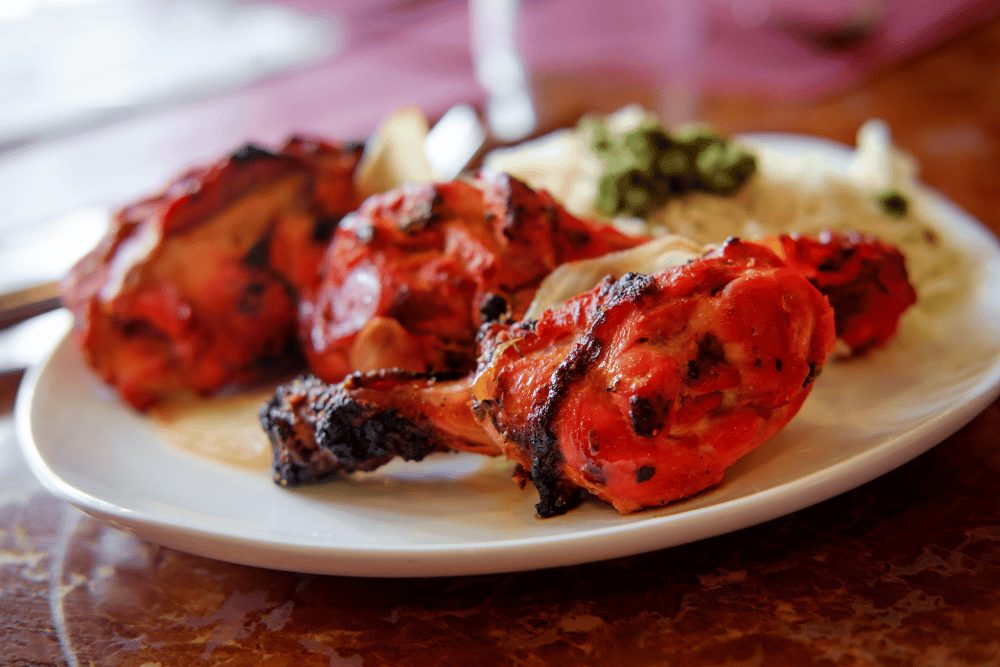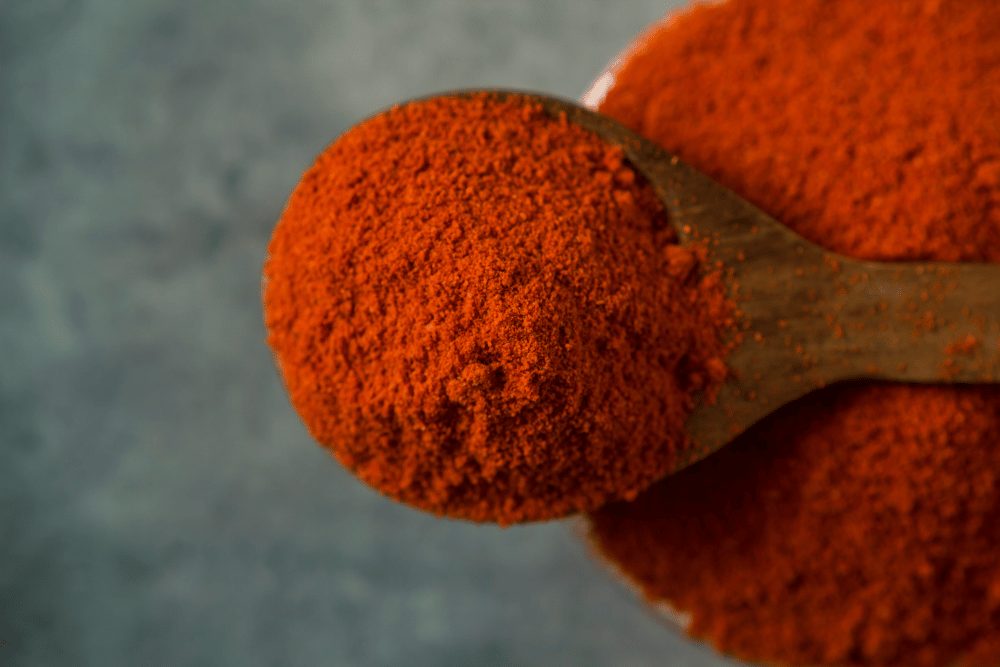Kashmiri chili is a mild dried Indian red pepper often ground into Kashmiri chili powder and used to flavor traditional cuisines. Aside from the chili being popular in its area of origin, Kashmir, neighboring regions, including Bangladesh and Pakistan, use it in their local dishes.
What Is Kashmiri Chili?
Kashmiri chili is a unique, relatively rare, Kashmiri-bred spice. It’s the secret ingredient behind the deep, attractive, stunning red hue in traditional Indian food, curries and stews.
Kashmiri chili’s popularity is mainly due to its unique hue and mild heat that doesn’t overpower the flavors. Also known as Kashmiri lal mirch or Kashmiri mirch, the pepper is an heirloom variety of capsicum annum species.
This chili is rare to find outside India, the leading grower, consumer, and exporter. South Asian cuisine lovers use Kashmiri chili instead of traditional coloring ingredients such as rafan jot (alkanet roots) and mawal (red cockscomb flowers).
In addition to coloring, Kashmiri chili gives ristas, stews, soups, and curries a sweet flavor and subtle heat. While it’s available as whole dried chilis and flakes, ground dry red Kashmiri chili powder is the most used.

Origin
This sweet natural spice is native to the Pampore town of northern India’s Kashmir region. Due to its growing popularity, it is currently grown throughout India, Pakistan, and Bangladesh. Though scarce, dried chilis are sold worldwide in online stores.
Taste
Dried Kashmiri chilis have a fruity, sweet taste with a slight smokiness. They are also aromatic and tangy. Once the dried chilies are ground into a powder, they gain a deeper smoky, earthy flavor and fruitiness. They have a delicious balance between heat and flavor.
Appearance
Due to the drying process, the wrinkled skin of the chili has a crumpled texture. It has long, thin pods similar to byadgi chili. Mature Kashmiris are often 3 inches long and 0.8 inches wide. The Kashmiri chili powder is fine and smooth in texture, like other chili powders.
It’s easy to identify Kashmiri chili by its unique, vibrant red color caused by red carotenoid concentration. Whether whole, dried or powdered, the stunning hue of chili Kashmiri stands out. It’s more loved as a deep coloring and spicing agent than for flavoring.
Is Kashmiri Chili Hot?
Kashmiri chili is mild in spice. It has a rating of 1,000-2,000 SHUs on the Scoville scale. This mild heat level makes it versatile for different dishes.
In perspective, the hottest Kashmiri is closer to a mild jalapeno pepper’s heat (2,500-8,000 SHUs). A poblano chili (1,000-1,500) is slightly milder than Kashmiri, while the mighty habanero boasts 100-175 times more heat.
Are Paprika And Kashmiri Chili Powder The Same Thing?
Kashmiri and paprika are similar but not the same.
- Color: Kashmiri chili powder is vibrant red color, while paprika presents a deep red hue with shades of orange depending on the pepper varieties included.
- SHU/spiciness- Paprika has several varieties. Some are hot, but sweet or mildly spiced paprika is the most common type, rating 250-500 SHUs on the Scoville scale. In contrast, Kashmiri rates 1,000-2,000 Scoville heat units making it four to five times hotter.
- Taste: Paprika chili powder has a sweet, vegetal, earthy taste, with the smoked ones having a touch of smokiness. Kashmiri powder is similarly sweet, smoky, and fruity.
- Origin: Paprika originated from central Mexico, whereas Kashmiri is native to India’s Kashmir region.
How To Use Kashmiri Chilis
Kashmiri chilies are a staple ingredient in popular Indian cuisines. The following are excellent ways to use these color-rich peppers to flavor Indian dishes:
- Tandoori chicken/turkey– Swap the paprika or cayenne pepper in this Tandoori chicken recipe with Kashmiri chili powder for a sweeter, balanced spiciness and an attractive hue.
- Kashmiri Rogan Josh- Use Kashmiri chili powder in your lamb Rogan Josh for a flavorful delicacy.
- Kashmiri rista– Kashmiri mirch is great when used in the ristas, traditional saffron-flavored mutton meatballs.
- Asian garam masala– Traditional garam masala (‘hot’ ‘spices’) seasoning blends have cumin, coriander, cardamom, cinnamon, and cloves. Indian versions may also include Kashmiri chili powder.
- Vindaloo- Kashmiri chili’s mild heat and stunning red color make the classic curry dish tastier. Check out this recipe for making your own vindaloo spice mix with Kashmiri chilis. If curry isn’t your thing, try using it as a dry rub for your next barbecue!
- Mixed fresh fruits and vegetables– sprinkle a spoonful of Kashmiri chili on your fresh fruits for a pop of color and smoky flavor.
- Kebabs and meaty dishes– Kebabs, meaty and savory dishes also go well with Kashmiri chilies.
- Traditional curries and stews– Kashmiri chili powder gives traditional Indian curries and stews mild heat, fruity taste, and distinct aroma.

Where To Buy Kashmiri Chili
Kashmiri chilis are hard to find outside South-Asian countries.
It’s easier to find the more commonly-used Kashmiri chili powder online. You may also find dried whole peppers from online stores. If there’s an Indian market nearby, you may also find them there.
Substitutes For Kashmiri Chili Powder
If you run out of Kashmiri chili powder, use the below substitutes:
- Smoked paprika mixed with cayenne pepper – Paprika pepper has a taste and hue similar to Kashmiri. Since it’s milder in heat, add cayenne for spiciness.
- Ancho chili powder – Dried/ground ancho chilis are moderately-spiced and similar to Kashmiri’s fruitiness, earthiness, sweetness, and smokiness.
- Byadgi chilies – These chilis are bright red, making them a good Kashmiri substitute. However, use in moderation as byadgi is 50 times hotter than Kashmiri mirch.
Can You Grow Kashmiri Chilis?
Yes. Like other capsicum annum varieties, you can grow your own Kashmiri chili peppers in warm loamy soils.
To protect them from frosty weather, grow the pepper plants indoors first before transplanting them to your garden or backyard.
With proper care and maintenance, these chili plants grow up to one three feet high and are ready for harvesting within 80-90 days. Ample sun and adequate drainage are essential for all chili peppers.

